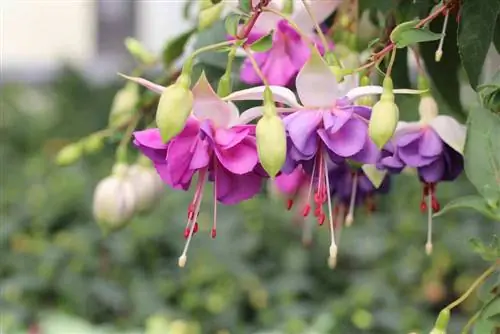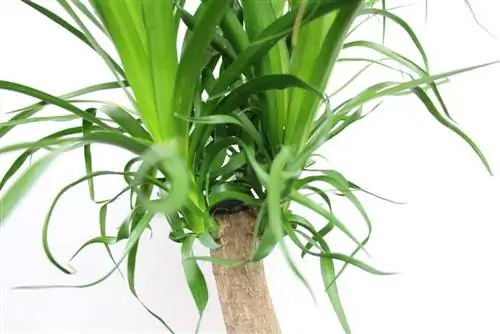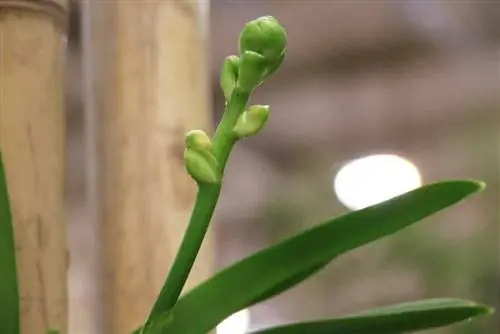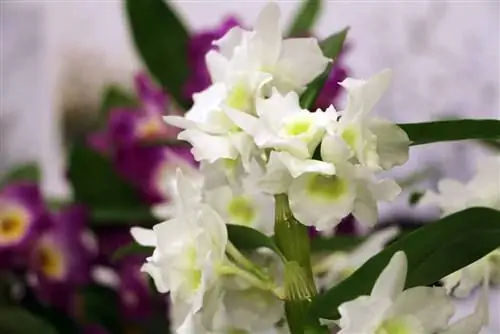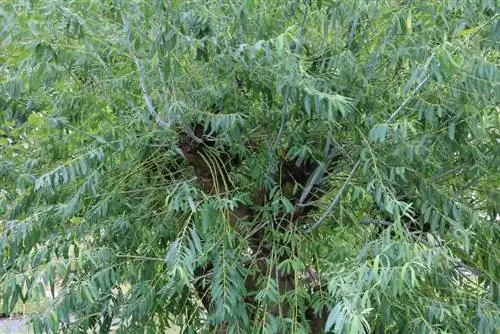- Author admin [email protected].
- Public 2023-12-17 03:39.
- Last modified 2025-01-24 12:45.
Fuchsias can even be planted as perennials in the garden; some flower lovers have also used them as blooming flower decorations on the grave. They were named after the German botanist Leonhart Fuchs.
What do fuchsias look like?
Fuchsia is a plant that grows as a subshrub, shrub or tree. In our latitudes it is mostly used for the balcony or terrace. It is a woody plant that can be kept for several years. Even if not everyone makes the effort to overwinter the fuchsias today, it is definitely worth it. The plants become more beautiful the older they get. Some have only a few branches, some grow much bushier and have finer stems. The flowers also look very different depending on the variety. Basically, fuchsias can be divided into these growth forms:
- upright growing
- overhanging growing
- hanging growing
Since there are so many varieties, it would be confusing to list a plant for every taste. However, the most popular ones are offered in garden centers, where they are waiting in spring with geraniums and other typical balcony plants. Not only are the flowers available in many colors, the leaves are also sometimes green or sometimes colorful. The flowers can also be of different sizes, they are single or double and some look like small ball gowns.
Cultivation through young plants
New plants can be grown either from cuttings, cuttings or by sowing seeds. Fuchsias can also be grown through young plants. If you don't yet have your own fuchsia, you may be able to get a shoot from your neighbor. In spring or autumn it is possible to take cuttings from a he althy plant. This is possible as long as the shoots are not yet woody. But they shouldn't be too young and therefore too soft. In addition, the cutting should have two pairs of leaves; the shoot is cut off with a sharp knife just below the lower leaf node. Then it can be put into potting soil. It is important to only use clean containers and, if possible, not to run the risk of pests taking over from old flower pots. Finally, a plastic bag is placed over the pot so that the moisture cannot evaporate so easily (greenhouse effect).
- Cuttings should be grown bright and warm at around 20 °C.
- The soil should only be kept moderately moist; it is sufficient to water the plant just once a day - preferably in the morning.
- After about three weeks, the small cutting has sufficient roots and can be potted into a larger pot with a diameter of approx. 7-9 cm.
- Now we wait until more roots have formed, then we can move it again into a larger pot.
Tip:
Don't put it in a large pot right away, otherwise the roots will develop more poorly.
This method is considered the most promising method of growing young plants from cuttings. Free-standing plants in nature reproduce naturally by scattering their seeds. Breeding with seeds in pots, on the other hand, is very complex and laborious, but at the same time it is not crowned with great success.
Growing from seeds
After flowering, a seed fruit develops in the same place. This contains the individual seeds, which sit in four chambers. The seed fruit must be cut open with a sharp knife and the seeds removed. They are laid out on kitchen paper to dry. When they are dry, they should immediately be placed in a growing tray with potting soil. This is followed by a layer of soil that is as thin as the thickness of the seeds, which is then moistened with a fine jet of water. If possible, cover with a transparent lid, glass pane or foil to retain heat.
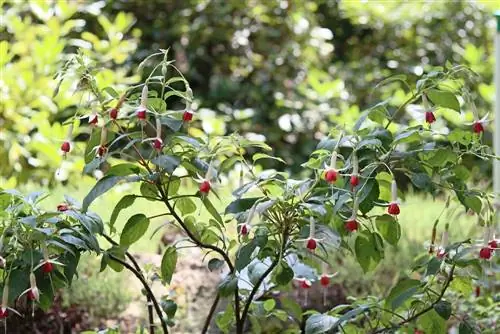
Once the seeds have germinated, the cover is opened every day for half an hour to acclimate the seedlings to the outside temperatures. When the plants have 2 pairs of leaves, they are placed in a 5-7cm pot. Again, a plastic bag is placed over this. It takes approximately 2-3 weeks for the plants to develop and form roots enough to be moved to a larger pot. They should be kept at a temperature of around 18-20 °C, but not exposed to direct sunlight. Careful ventilation, as with seedlings, also accustoms the young plant to the outside temperature and hardens it. Foliar fertilization gives the little fuchsia children the nutrients they need.
Offshoot by sinker
Another way to grow offshoots from the fuchsia is the lowering method. To do this, a fuchsia shoot from the mother plant - which should either be directly in the garden soil or directly on the ground - is bent sideways downwards. This must be done carefully so that the shoot does not break off. If it touches the ground in the area of one eye (leaf axil) and is fixed there, with a bit of luck it can take root. When these roots are large enough, the shoot is cut off from the mother plant and can then be placed in a pot. In addition to this method, it is possible to grow a new plant from a side runner. An older outdoor fuchsia can also be divided into two plants by division.
Propagate fuchsias with cuttings
Requirements:
- Plant pots with a diameter of approx. 9 cm
- Mini greenhouse
- growing soil
- Water
- a sharp knife (not scissors!)
Many garden centers offer plant pots specifically suitable for growing fuchsias. Use mesh pots, clay pots or simple plastic cups. The general rule is: The soil must be perforated so that the root ball can absorb a lot of water. When using clay pots, please note that fuchsia cuttings require more water because clay increases the evaporation of water. Many home gardeners use simple potting soil to grow cuttings. However, special potting soil is optimal for growing plant cuttings, as the mineral content is adapted to the needs of cuttings.
- For fuchsias, top cuttings are used, which also include some of the leaves underneath.
- The best time for taking cuttings is generally spring, as the plant then quickly forms roots.
- In general, cuttings must be cut with a sharp knife to prevent the conductor tracks in the shoots from being damaged.
- In the first few weeks, the fuchsia cuttings must be placed in a mini greenhouse with sufficient humidity.
- If you don't have such a greenhouse, you can also cover a flower pot with cling film and place the pot on a warm heater.
- To accelerate the rooting of the fuchsia cuttings, rooting powder is offered - but rooting can be successful even without this aid.
- The cuttings also need to be well supplied with water. However, no backwater must form, otherwise the small roots will quickly rot.
- Drain excess water immediately!
- The first rooting phase usually takes 2 weeks. During this time you should not lift the lid of the greenhouse or the film and avoid ventilation.
- After 2 weeks you can repot the cuttings into plant pots. For this purpose, a separate pot must be used for each cutting.
- The potting soil is no longer necessary, simple potting soil is sufficient.
- If the cutting subsequently forms new leaves, the cultivation of new fuchsias was successful.
What you should know in brief
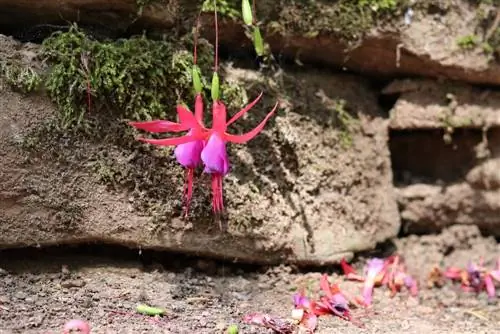
Fuchsias are among the most popular plants for balconies and gardens. Especially due to the diversity of this particularly lushly flowering plant, garden owners often develop a passion for collecting. Most plant lovers are familiar with hanging fuchsias, but in Europe alone you can find almost 6,000 different species. In addition to the well-known hanging fuchsias for hanging baskets, these also include bushy plants, fuchsias that grow on stems as potted plants, or ground-covering fuchsias.

